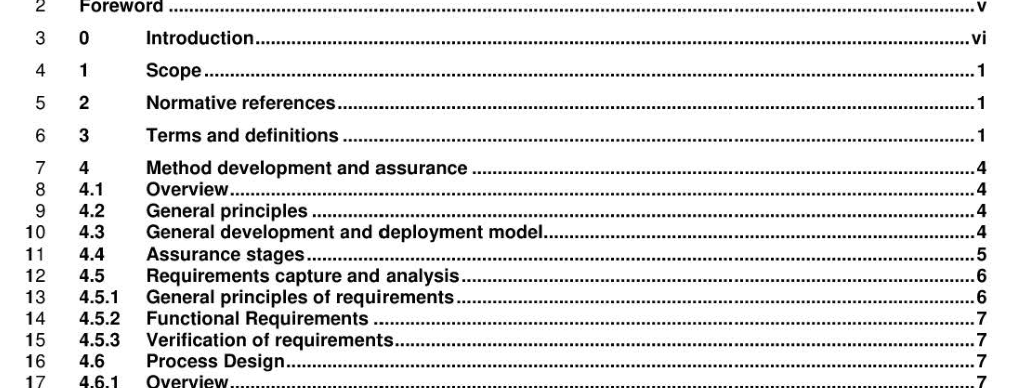ISO IEC 27041-2013 pdf Information technology – Security Guidance on assuring suitability and adequacy of incident investigative methods

Prior to designing a process for use in an examination, a proper set of requirements should be produced, accepted by the client and recorded in accordance with good practice. This set of requirements should be derived from the requirements identified for the complete investigation and may include both functional and non-functional requirements. A requirement is a statement which expresses a need and its associated constraints and conditions. Conditions are measurable qualitative or quantitative attributes which can be used to qualify requirements. Constraints are restrictions on the design or implementation of the solution, such as interfaces to existing systems, physical size limitations or local policies. Each requirement defines an essential capability, characteristic or quality factor. Each individual requirement statement should be necessary, implementation-free (ie. it states only what is required, not how the requirement should be met),unambiguous, complete, singular and consistent with the remainder of the requirements in the set. Requirements vary in intent and in the kinds of properties they represent. They can be grouped together into similar types to aid in analysis and verification. Examples of types of requirements include: ●Functional – describe the functions or tasks to be performed and will include such considerations as expected inputs and outputs; ●Performance – defines the extent, how well, and under what conditions a function or task is to be performed; Interface – defines how the solution interacts with external systems, or how elements within the solution (including human elements) interact with each other; ●Process – include compliance with local laws and processes or administrative requirements; ●Non-functional – define how a solution is supposed to be, including quality requirements such as portability, reliability, maintainability and security, or human factors requirements such as safety, efficiency or health and wellbeing.
Functional requirements are those stemming directly from investigative needs and which are expected by the users of the process. They do not define how the process should operate but will include such considerations as expected inputs and outputs. All functional requirements should be satisfied by the investigation.
- Previous:ISO IEC 29121-2013 pdf Information technology — Digitally recorded media for information interchange and storage — Data migration method for DVD-R, DVD-RW, DVD-RAM, +R, and +RW disks
- Next:ISO IEC 17067-2013 pdf Conformity assessment — Fundamentals of product certification and guidelines for product certification schemes
- ISO IEC 27050-4-2021 pdf Information technology — Electronic discovery — Part 4: Technical readiness
- ISO IEC 27036-1-2021 pdf Cybersecurity — Supplier relationships — Part 1: Overview and concepts
- ISO IEC 27013-2021 pdf Information security, cybersecurity and privacy protection — Guidance on the integrated implementation of ISO/IEC 27001 and ISO/IEC 20000-1
- ISO IEC 26580-2021 pdf Software and systems engineering — Methods and tools for the feature- based approach to software and systems product line engineering
- ISO IEC 24735-2021 pdf Information technology — Office equipment — Method for measuring digital copying productivity
- ISO IEC 24711-2021 pdf Information technology — Office equipment — Method for the determination of ink cartridge yield for colour inkjet printers and multi- function devices that contain printer components
- ISO IEC 23544-2021 pdf Information Technology — Data centres — Application Platform Energy Effectiveness (APEE)
- ISO IEC 23510-2021 pdf Information technology — 3D printing and scanning — Framework for an Additive Manufacturing Service Platform (AMSP)
- ISO IEC 23127-1-2021 pdf Information technology — Learning, education, and training — Metadata for facilitators of online learning — Part 1: Framework
- ISO IEC 23126-2021 pdf Information technology for learning, education and training — Ubiquitous learning resource organization and description framework
- IEC 60317-47-2013 pdf Specifications for particular types of winding wires – Part 47: Aromatic polyimide enamelled rectangular copper wire, class 240
- IEC 61156-8-2013 pdf Multicore and symmetrical pair/quad cables for digital communications – Part 8: Symmetrical pair/quad cables with transmission characteristics up to 1 200 MHz – Work area wiring – Sectional specification
- IEC 62488-3-2021 pdf Power line communication systems for power utility applications – Part 3: Digital Power Line Carrier (DPLC) Terminals and hybrid ADPLC Terminals
- IEC 60205-2009 pdf Calculation of the effective parameters of magnetic piece parts
- IEC 60695-11-11-2021 pdf Fire hazard testing – Part 11-11: Test flames – Determination of the characteristic heat flux for ignition from a non-contacting flame source
- BS ISO IEC 15420-2009 pdf Information technology一 Automatic identification and data capture techniques EAN/UPC bar code symbology specification
- BS IEC 60860-2014 pdf Radiation protection instrumentation一 Warning equipment for criticality accidents
- BS ISO IEC 19762.5-2008 pdf Information technology一 Automatic identification and data capture (AIDC) techniques – Harmonized vocabulary Part 5: Locating systems
- ISO IEC 24735-2021 pdf Information technology — Office equipment — Method for measuring digital copying productivity
- ISO IEC 24711-2021 pdf Information technology — Office equipment — Method for the determination of ink cartridge yield for colour inkjet printers and multi- function devices that contain printer components